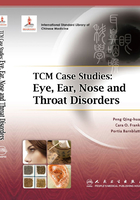
上QQ阅读APP看书,第一时间看更新
CASE SCENARIOS
The following cases present variations of this condition. After familiarizing yourself with the possible common pattern presentations and appropriate formulas for treatment, use the following exercises to test your overall understanding of the condition.
1. A female patient, age 42, felt dry and painful in her right eye for a month and got better with the treatment of Western and Chinese medicine. 3 days ago, the pain in her right eye got worse with her anger. Other symptoms and signs included burning heat, photophobia, dramatic decline of her eyesight, rib-side distention and pain, dry throat, biter mouth, dry stool and yellow urine. Examination showed ciliary hyperemia in the right eye, geographic opacity at the bitemporal part of the cornea, a red tongue with a yellow coating, and a wiry rapid pulse.
What is the treatment principle?
A. Scatter wind and clear heat.
B. Clear heat and resolve toxin.
C. Clear liver heat and drain fire
D. Clear heat and eliminate dampness
2. A male patient, age 39, had pain in his left eye for five months, sometimes serious and sometimes mild. Four days ago, his eye pain was aggravated, hot tear, heavy sensation of the head, chest distress, anorexia, and loose stool. Examination showed ciliary hyperemia in the lef eye and disc-like opacity in the deep layer of the cornea, a red tongue with a yellow coating, and a soggy rapid pulse.
What is the preferred formula for this disease?
A . Sān Rén Tāng (Three Kernels Decoction)
B . Xiè Qīng Wán (Green-Blue Draining Pill)
C . Lóng Dăn Xiè Gān Tāng (Gentian Liver-Draining Decoction)
D. Zhú Yè Xiè Jīng Tāng (Lophatherum Channel-Draining Decoction)
3. A female patient, age 50, sufered from dryness in the lef eye for 2 years. Five days ago, her condition was worsened. Her chief symptoms of dryness, slight pain and slight photophobia in the left eye, and dry mouth and throat. Examination showed mild conjunctival hyperemia, sporadic punctate opacities at the cornea, a red tongue with litle coating, and a thready rapid pulse.
What is the treatment principle?
A. Dispel wind and clear heat
B. Enrich yin and dispel wind
C. Clear liver heat and drain fre
D. Enrich yin and subdue fre
Answers
1. C
2. C
3. B
Additional Commentary
Several other formulas are suggested for the treatment of herpes simplex keratitis:
In The introduction of the chapter, the author lists three other primary patterns and formulas:
The presentation of blazing liver-gallbladder fre is presented in Case 1: All of the patient’s symptoms obviously point to this diagnosis. The formula for this patern is Lóng Dăn Xiè Gān Tāng (Gentian Liver-Draining Decoction) modifed with yĕ jú huā (Flos Chrysanthemi Indici) and mù zéi (Herba Equiseti Hiemalis) to clear hear and abate the nebula.
The second pattern is damp-heat steaming. This presentation is illustrated in Case 2. Here, the hallmark signs of heaviness, chest oppression, poor appetite and loose stool, along with the tongue and pulse presentation pave the road towards this diagnosis. Other local signs of damp and damp heat patterns include ciliary congestion, recurrent outbreaks, and slow healing. The formula for this pattern is modified Sān Rén Tāng (Three Kernels Decoction). This Wen Bing formula treats patterns of early stage damp warmth. Because the structure of the formula is not directed at the eyes, per se, it requires modifcation. The English edition of PMPH’s ophthalmology textbook offers a drastically modified version of Sān Rén Tāng, creating a formula that dispels damp-warmth and drains damp-heat in the liver channel:
Formula: Modifed Sān Rén Tāng (Three Kernels Decoction)
[三仁汤加减]

Bái dòu kòu (Fructus Amomi Kravanh), dàn zhú yè (Herba Lophatheri), huá shí (Talcum) and tōng căo (Medulla Tetrapanacis) are omited from the original formula, while yīn chén, zhī zĭ, chái hú, huáng qín, huáng lián, chén pí, qín pí and huò xiāng are added. Virtually all these medicinals are biter and cold. Most of them enter the liver channel, most of them reference other well known fre-clearing formulas including, but not limited to Yīn Chén Hāo Tāng (Virgate Wormwood Decoction) and Huáng LiánJiĕ Dú Tāng (Coptis Toxin-Resolving Decoction).
The patern of yin defciency with wind is represented in Case 3. It is characterized by a long duration, with recurrences that wax and wane. The ciliary congestion is milder than in paterns that involve fre. In this case, her symptoms of dryness, slight pain and slight photophobia in the left eye, and dry mouth and throat all point to yin defciency with dryness. Although there are no obvious symptoms of wind, the suggested Treatment Principle is to Nourish yin and dispel wind using modifed JiāJiăn Dì Huáng Wán (Modifed Rehmannia Pill, 加减地黄丸) that was recorded in the Enlightenment of Ophthalmology ( Yuán Jī Qĭ Wēi, 原机启微).
Ingredients:

[Formula Analysis]
Shēng dì and shú dì huáng nourish kidney yin.
Dāng guī nourishes the blood; niú xī invigorates blood and guides the defcient fre downward.
Qiāng huó and fáng fēng dispel wind and remove nebula.
Zhī mŭ and huáng băi clear defciency fre
Jú huā and chán tuì dispel wind, clear heat and remove nebula.